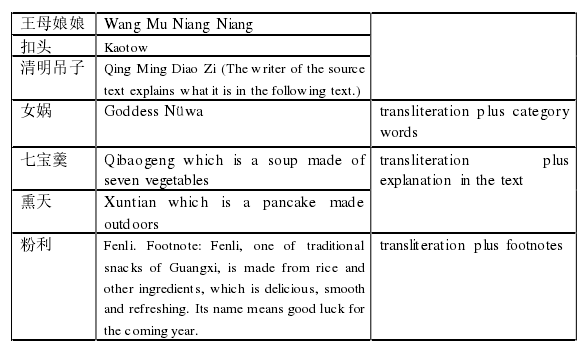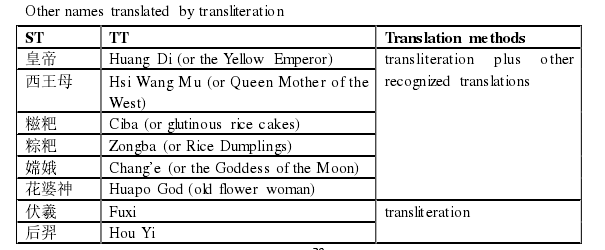本文是一篇英语毕业论文,在这次翻译中,作者遇到了许多挑战和困难。同时,对翻译的理解也在加深,实践能力也在提高。其启示如下:首先,译者在译前理解中的主体性在民俗翻译中起着至关重要的作用。选择合适的原文和文化立场,阅读相关的平行文本和文献,充分利用网络资源和咨询他人,是实现译者与原文视域融合的可行而有用的方法。
Chapter One Introduction
1.1 Background of the Project
Guangxi Zhuang Autonomous Region is the most populous place where the Zhuang people live. The rich Zhuang culture has been the representative of Guangxi culture. Against the background of enhancing culture as the soft power of our country, the publicity, especially the translation of the Zhuang culture is undoubtedly of great significance to the strategy of Chinese culture “going global”. However, the number of the English monographs to introduce the colorful culture of the Zhuang nationality and the researches on the English translation of the Zhuang culture is quite small. For a private reason, the author who is of Han nationality has been deeply amazed and attracted by the strong national characteristics of Guangxi since the author came to Guilin to start her postgraduate study. With the guidance of her supervisor, Pe ng J ins o ng, who is a bachelor devoted to the study of the Zhuang culture, the author decided to choose the translation of the Zhuang culture as the study orientation of my thesis.
The translation material is from the first three chapters of Praise of Spring: Sanyuesan Singing Festival of the Zhuang Nationality by Li Fuqiang, a leading scholar of the Zhuang studies, and the rest two chapters are translated by the author ‟s classmate. The author found this book by chance on a website which is aimed at recommending the e-books about “Sanyuesan”, a grand and traditional festival of the Zhuang ethnic group. Published by Guangxi People‟s Publishing House in 2018, it is a perfect publicity material to introduce Guangxi folklore for its detailed and trustworthy facts, simple and exact language as well as interesting and vivid illustrations. Soon the author decided to take this book as her translation material. Then the author contacted the writer Professor Li Fuqiang to ask for his authority to translate his book. To the author ‟s excitement, he generously agreed to her request, which gave her great support and encouragement.
1.2 Significance of the Project
The traditional Chinese “Sanyuesan Festival” is especially grand in Guangxi, which has been listed as a statutory holiday since 2014. “Sanyuesan Festival” of the Zhuang people enjoys a longstanding history. At this festival, many celebration activities are held, including not only ordinary ones like outing, worshipping ancestors and gods, but also interesting ones like anticipating in folk song fairs, climbing mountains, cockfighting, and enjoying delicious food. Among these activities, anticipating in folk song fairs is the most distinctive one at “Sanyuesan Festival” of the Zhuang ethnic group, which is the origin of its another name, “Singing Festival”. It is the colorful and unique folk customs that display the deep cultural deposits of the Zhuang nationality as well as the profoundness of Chinese culture. So under the strategy of Chinese culture “going global”, it is of great significance to spread the outstanding and representative culture of China ‟s ethnic minorities to introduce a more diverse China to the rest of the world.
Undoubtedly translation plays a crucial role in cultural exchanges. The scholar Wang Kefei (1997,2) put forward that translation was the product of cultural exchanges;Translation activity and culture were inseparably intertwined. Considering the present study of the folk cultures of China‟s ethnic minorities is insufficient and the monographs focusing on “Sanyuesan Festival” are even less, Praise of Spring: Sanyuesan Singing Festival of the Zhuang is a valuable and perfect work to introduce the culture of the Zhuang people. Translating the book unavoidably involves the translation of the Zhuang culture, which actually is the most important and difficult part in translating folklore texts. Therefore, it is expected that the translated version can offer the foreign readers who are interested in the culture of China‟s ethnic minorities a better reading choice and show the diversity of Chines culture to promote cultural exchanges.
Chapter Two Translation Process
2.1 Pre-translating Preparation
In translation process, pre-translating preparation is the most easily ignored but a key part, which is indispensable for improving and ensuring the quality of renderings no matter for translation or interpretation (Xiao Anfa, 2010). The source text, parallel texts and related literature will be included in this part. What‟s more, it is necessary and enlightening to study the general principles of C-E translation to better guide the translation.
2.1.1 Analysis of Source Text
The source text of this translation practice is from Praise of Spring: Sanyuesan Singing Festival of the Zhuang Nationality. The book was written by Professor Li Fuqiang, a prominent scholar of the Zhuang study o f Guangxi University for Nationalities. Professor Li, mainly engaged in the study of the history of Chinese ethnic minorities, the Zhuang study and anthropology, has presided over 20 scientific research projects of different levels, published 13 monographs, 1 translation and over 100 papers and research reports by 2018.
This book introduces the traditional “Sanyuesan Festival” of the Zhuang people in a systematic and detailed way from the five perspectives of longstanding history, distinctive customs, delicious food, magical legends and constant inheritance. Chapter one introduces the historical connections between “Sanyuesan Festival” and Huang Di, Fuxi, Goddess N üwa, Wang Mu Niang Niang and Shangsi Festival. Chapter two is centered with the rich customs and their cultural significance of “Sanyuesan Festival”, including folksong fairs and courtship, ancestor worshipping and tomb sweeping, mountain climbing, cockfighting and huapao snatching. Chapter three elaborates on the traditional delicious food that the Zhuang people enjoy at this festival and their recipes like five-colored glutinous rice, ciba, zongba, five-colored boiled eggs and vegetable spring rolls. Chapter four is the touching stories about the origin and customs of “Sanyuesan Festival”, reflecting the understanding of the Zhuang people to the festival and their moral values. The last chapter is a brief description of the development of “Sanyuesan Festival”, especially focusing on the prosperous development since 2014 when it was listed as the statutory holiday. The author, based on her interest and text coherence, chooses the first three chapters which have about 16,000 Chinese characters in total as her translation text.
2.2 Translation Execution
Translation execution plays a crucial role in the whole translation process. In this part, the author will elaborate on the translation tools, the translation difficulties and solutions.
2.2.1 Translation Tools
In a broad sense, translation tools refer to all the software and hardware facilities that can provide convenience for translation, such as word processing software and equipment (including computers), scanners, recording equipment, text format conversion software, electronic dictionaries, online dictionaries, etc.; in a narrow sense, translation tools are CAT software designed to improve translation efficiency and to optimize translation process (Xu Bin et al., 2007). In this translation practice, the translation tools the author utilized are mainly included in the former one.
To begin with, the rich e- literature was provided by the internet. Most of the books about Guangxi culture and Zhuang studies the author consulted are from the digital library of Guangxi Normal University and papers from CNKI. A small number of books the digital library didn‟t have were gained from Taobao‟s platform of e-books finding. These e-resources did offer convenience to the author and improved her efficiency during the translation process.

Chapter Three Theoretical Frame work ................................ 15
3.1 An Overview of Reception Aesthetics .......................................... 15
3.1.1 Indeterminacy ....................................... 15
3.1.2 Readers‟ Subjectivity ................. 16
Chapter Four Case Analysis ....................................... 23
4.1 Translator‟s Subjectivity in Pre-translating ..................................... 23
4.1.1 Translator‟s Subjectivity in Selecting the Source Text ...................................... 23
4.1.2 Translator‟s Subjectivity in Pre-translation Understanding............................... 25
Chapter Five Conclusion ....................................... 43
5.1 Enlightenments .......................... 43
5.2 Limitations and Suggestions ......................................... 44
Chapter Four Case Analysis
4.1 Translator’s Subjectivity in Pre-translating
According to Reception Aesthetics, in order to realize the fusion of the horizons of the text and the readers, a translator must make full use of his or her initiative in translation. Pre-translating preparation plays an important role in the whole translation process. From choosing and reading the source text, searching for parallel texts and the information about the writer to making a word list about Guangxi folklore, translator ‟s subjectivity is fully shown in the pre-translating preparation. Next, the author will analyze how she gave full play to her initiative in pre-translating.
4.1.1 Translator’s Subjectivity in Selecting the Source Text
The process of translation is the process of making choices (Fan Xiangtao, 2002). Each choice is related with translation goals. Having decided to take the translation of the Zhuang culture as the orientation of her thesis, the author began to find appropriate translation materials.
Before choosing the source text, a research about the status quo of the publicity of the Zhuang culture had been conducted. Generally speaking, the English books to introduce the Zhuang culture are far from sufficient, which can be roughly divided into two groups. First, most English monographs focus on a panoramic introduction to the Zhuang, like Zhuang History and Culture: The Zhuang: A Longitudinal Study of Their History and Culture (Jeffrey G. Barlow, 2001), An Introductory Study (Jin Lin, 2007), A Study of Zhuang Group in the Process of a Modern State (Lu Lu, 2016) and so on; second, the English translations concentrate on the translation of folksongs, ancient books and records, such as The Zhuang Folk Stories (Jin Li, Meng Yuanyao, 2010), Liao Songs of Pingguo Zhuang (Zhou Yanxian, Lu Lianzhi, 2011), The Epic of Bacuqloxgdoh (Han Jiaquan, 2012), Translation of Selected Zhuang Minority Folk Songs (Su Huihui, Tan Liping, Huang Xingyun, 2017), Two Thousand Zhuang Proverbs from China with Annotations and Chinese and English Translation (Zhou Yanxian, 2017) and so on. It is these scholars‟ unremitting efforts that greatly promote the publicity of the essence of the Zhuang culture. However, the English literature is mainly about the serious academic study and ancient books which are obscure for the ordinary foreign readers who have little understanding of the Zhuang minority. As is often the case, if a book covers the field that is totally strange for most readers, it is something interesting that attracts readers to read it. Ma Yixin (1998: 214) put, “there are no more than two requirements of readers: one is to understand at least; the other is to get something after reading.”

Chapter Five Conclusion
5.1 Enlightenments
In this translation, the author encountered many challenges and difficulties. Yet meanwhile, the understanding of translation is deepened and prac tical capacity improved. The enlightenments are as follows:
First, translator ‟s subjectivity in pre-translating understanding plays a crucial role in folklore translation. Choosing appropriate source text and cultural position, reading related parallel texts and literature, making full use of online resources and consulting others are feasible and useful methods to help to fulfill the fusions of the horizons of the translator and the source text.
Second, in order to realize the horizons of target readers a nd the source text, a translator should show concern for target readers‟ language habits, cognitive demands and aesthetic features. The three aspects are not isolated but closely integrated. Precise understanding and wording, concise expressions, adjusting sentence structures can make target text more idiomatic. As for the informative parts of the source text, translation methods like making footnotes, substitution, addition, omission, free translation can be taken flexibly according to specific conditions. Meanwhile, a translator should be familiar with the difference of the modes of thinking between Chinese and westerners so as to translate in a bolder but reasonable way.
Third, foreignization should be taken to guide the translation of culture- loaded words and response inviting structures. Transliteration and literal translation are the main methods to deal with them, which keep not only the cultural elements of the source text, but also a certain aesthetic distance requiring readers to actively participate in the reading process.
reference(omitted)
